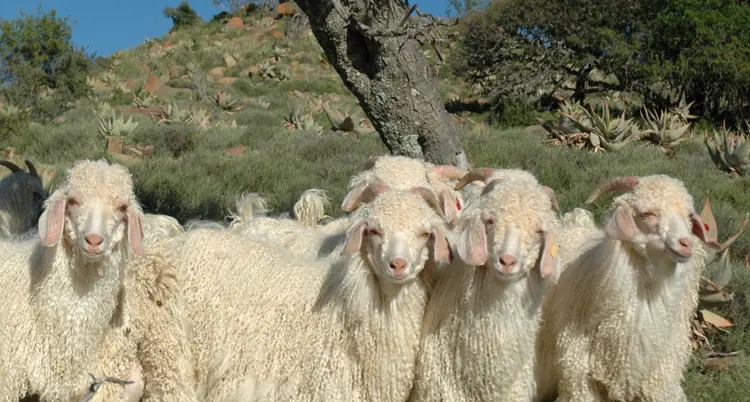
The principles of fine wool/mohair (fleece) production are physiologically more or less the same, but the vehicle (animal) differs to a large extent, and the feeding and management approach should be different.
However, the basics are:
- Fleece production is dependent on the development of primary and secondary follicles in the skin of the animal.
- This is determined by genetics, birth weight, size (surface) of the skin, and nutrition.
- The follicles (of the lamb) start developing from 60 days after conception, and maturity (activation) occurs from 35 days before lambing until 12 weeks after lambing.
- If the follicles do not mature, the lifetime fleece production will be affected – this is irreversible.
- The ratio between primary and secondary follicles (P:S) determines the quality of the wool. In Angoras the average P:S follicle ratio is 1:10 with a corresponding average of 30 microns. In merinos the P:S ratio is 1:20 with a corresponding average of 18 - 20 microns.
How is nutrition managed for increased fine wool / mohair production?
Wool/mohair consists predominantly of keratin which is a complex protein made up of 20 different amino acids (protein building blocks) and contains 2,7% - 3,4% sulphur. To increase wool/mohair production it makes sense to supply these sulphur-containing amino acids, but it is not that simple.
Why?
- The first limiting factor is DMI (dry matter intake). If an animal does not have sufficient DMI, supplementation of amino acids will be futile. First provide enough grazing.
- Proper rumen function is the next best solution. If the rumen is kept healthy and functioning properly by providing constant rumen degradable nutrients (supplements), most amino acids will be supplied by microbial protein. This is nature’s way of ensuring bypass protein.
- Balanced feeding. Supplement amino acids to increase the yield. The efficiency of supplementing amino acids to increase fleece production is dependent on the energy balance of an animal. When an animal has a strong positive energy balance, the utilisation of amino acids is 47% but when an animal has an energy equilibrium, the efficiency is 14%.
Trials and results
De Heus has been leading several customer on-farm commercial trials to establish what can be done not only to increase fleece production, but also how to do it economically.
SHEEP TRIALS
Several trials were run on sheep over a two-year period with six-months intervals from one shearing to the next. Unfortunately, none of these trials could be completed because of the drought situation, and the different treatment groups had to be combined after three/four months into the trials and fed drought feed for two consecutive years. The trial periods were shortened as a result.
It was possible, however, during the shortened trials, to see a difference that was economically justified between the production traits of the treatments, even within the drought situation.
ANGORA TRIALS
The Angora trial was conducted over a longer period of three years (and is still on-going). During these trials, different trial rations were supplied, but the quantity was increased according to the situation.
During the first year the difference in response between a “normal” supplementation (clients current feed) and a ration that focused on rumen health and functionality was tested (SFOS Formulation from De Heus).
With marked improvement on the SFOS formulated ration, these were continued for the next two years, and different levels and ratios of amino acids and other nutrients (SFOS+ and SFOS ++) added.
The results are summarised in the table below:
* During the severe part of the drought, these levels were increased.
The following was observed during the trials (even through the drought):
- an INCREASE in mohair yield from 0,8 kg over a 6-month period to 1,8 kg over a 5-month period;
- an INCREASE in length from a D to a C; and
- an INCREASE in average body weight.
Although the ration with the highest levels of amino acids (SFOS++), outperformed the others in terms of production, the increase in cost thereof did not justify the additional benefits.
Summary
As with all things in life a delicate balance between genetics, management, and nutrition is the key to optimal success. One cannot do without the other. Having said that, dramatic increases in the yield of mohair and wool when nutrition has been addressed within the same genetics and similar management conditions have been recorded.
When basics such as DMI (dry matter intake) and energy equilibrium are in place, great advances can be made with proper formulation techniques to stimulate and maintain rumen functionality, and added amino acids, minerals, and trace minerals.


